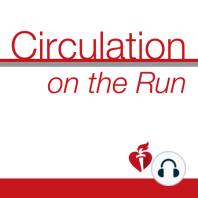16 min listen
Circulation September 9, 2020 Issue
ratings:
Length:
20 minutes
Released:
Sep 8, 2020
Format:
Podcast episode
Description
This week’s episode includes author Charlotte Andersson and Associate Editor Naveed Sattar as they discuss familial clustering of aortic size, aneurysms, and dissections in the community. TRANSCRIPT: Dr Carolyn Lam: Welcome to Circulation on the Run, your weekly podcast, summary, and backstage pass to the journal and its editors. I'm Dr Carolyn Lam, Associate Editor from the National Heart Center and Duke national University of Singapore. Dr Greg Hundley: And I'm Greg Hundley, director of the Pauley Heart Center at VCU health in Richmond, Virginia. Well, Carolyn, our feature this week has to do with aortic size, aneurysms, and predilection to dissection. But before we get to that, how about if we grab a cup of coffee and go through some of the other articles in the issue? Dr Carolyn Lam: I got my coffee, Greg, and you know what? I'm going to start with quiz for you. Dr Greg Hundley: All right. Dr Carolyn Lam: True or false, in the setting of obesity and/or diabetes, cardiac substrate metabolism shifts towards increased fatty acid oxidation, while lipid accumulates in the heart? True or false? Of course, you're right. Oh, but there's a part two. Can you guess, by increasing fatty acid oxidation, will we induce or prevent obesity-induced lipotoxic cardiomyopathy? Dr Greg Hundley: I'm going to say, because you asked it in the way you asked it, prevent. Dr Carolyn Lam: Wow. All right. Well, the truth is we didn't really know before today's paper. The specific link between cardiac metabolism and lipotoxic cardiomyopathy was elusive and there was no specific therapy available for this condition. And these authors, Dr Rong Tian from University of Washington and colleagues, hypothesized that cardiac pathology-associated obesity would be attributable to the imbalance of fatty acid supply and oxidation. So using a diet-induced obesity model in the current study, they demonstrated that enhancing fatty acid oxidation through deletion of acetyl-CoA carboxylase 2, was sufficient to prevent obesity-induced cardiomyopathy. So, increasing cardiac fatty acid oxidation alone does not cause cardiac dysfunction, but instead protects against cardiomyopathy in chronically obese mice. The cardiac-protective effect of increasing fatty acid oxidation and obese mice is through maintenance of Parkin-mediated mitophagy, and thus preventing mitochondrial dysfunction. These findings indicate that impaired mitophagy contributes to mitochondrial dysfunction in obese mice, and that targeting the Parkin-dependent pathway is a viable therapeutic intervention for obesity-induced cardiomyopathy. Dr Greg Hundley: Very nice. Carolyn. Dr Carolyn Lam: I'm going to be greedy and go on to my next paper. So Greg, do you think cardiac regeneration is possible? Dr Greg Hundley: Well, Carolyn, I would have said, several years ago, no, but that trip that we took to China with Joe Hill and Hesham Sadek, our Associate Editor and our Chief Editor, convinced me otherwise. So I'm going to definitely answer yes on this one. Dr Carolyn Lam: Oh, Greg, you're just too smart. And speaking of China, this next paper is from there, from co-corresponding authors, Dr Nie and Hu, from Fuwai Hospital National Center for Cardiovascular Disease and Chinese Academy of Medical Sciences and Peking Union Medical College. So, using seven genetic mouse lines, they identify that Oncostatin M is the top upregulated cytokine during neonatal heart regeneration. Oncostatin M is a pleiotropic secretory protein that belongs to the interleukin 6 family, and associates with the pathological process of dilated cardiomyopathy. And these authors found that macrophages promote heart regeneration by secreting Oncostatin M, which promotes cardiomyocyte proliferation via a co-receptor, gp130. Employing RNA-seq and functional screening, they further found that Src-mediated gp130 triggered cardiomyocyte proliferation by activating the downstream signaling pathway involving Yap, with Y357 phosphorylation independent
Released:
Sep 8, 2020
Format:
Podcast episode
Titles in the series (100)
Circulation August 30, 2016 Issue: Circulation Weekly: Your Weekly Summary & Backstage Pass To The Journal by Circulation on the Run
